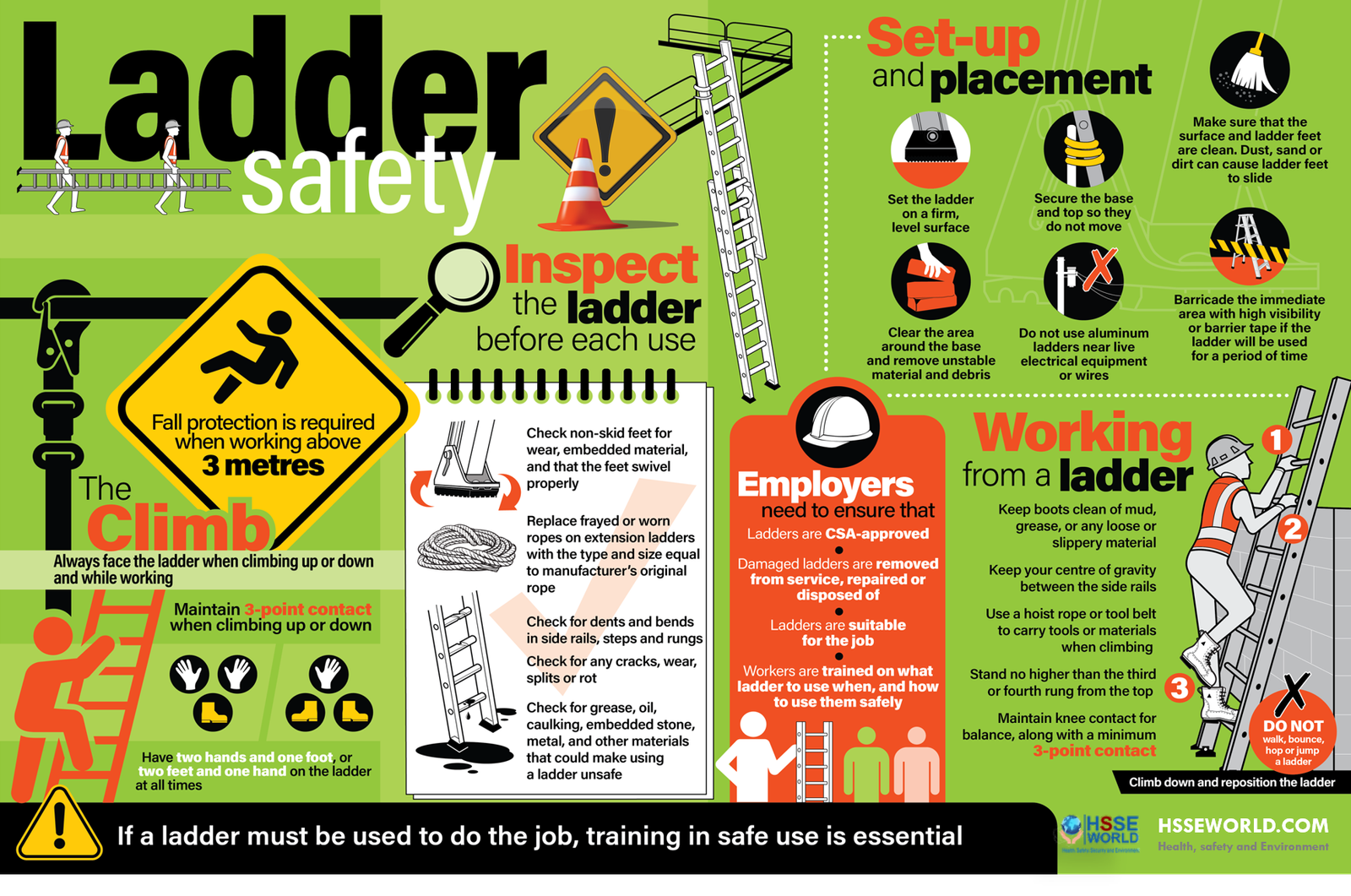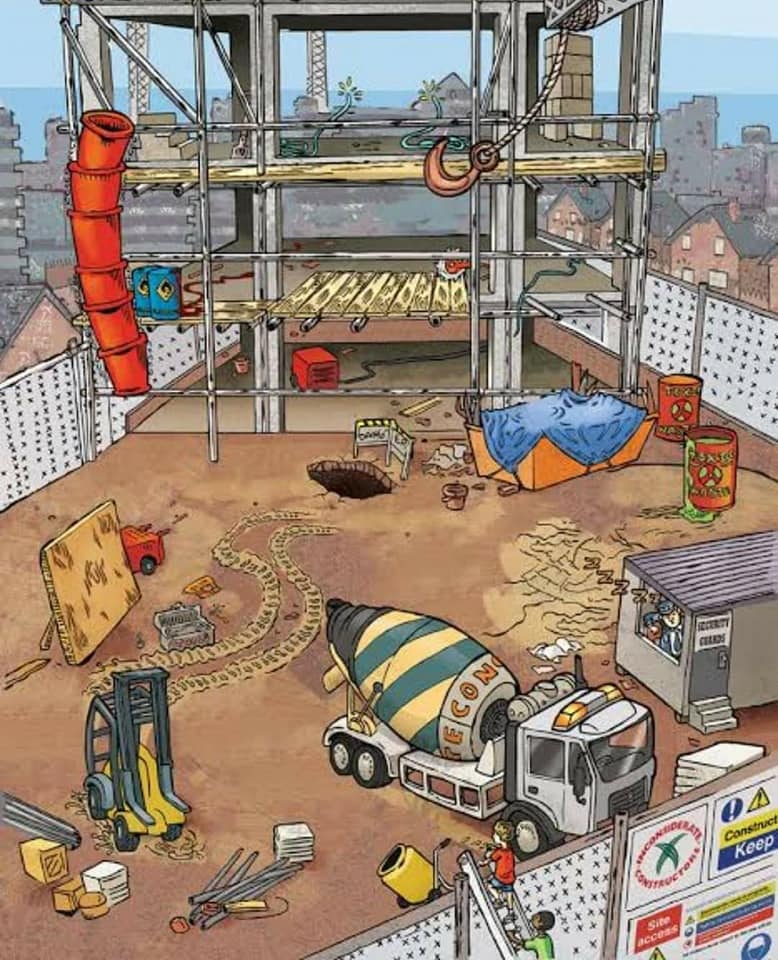OSHA’s walking and working surface safety regulations include working from ladders. One of the most popular workplace tools in both construction and industry can often pose a safety risk when used incorrectly. According to OSHA, slips, trips, and falls continue to be the number one cause of workplace injuries, with almost 30% of workplace injuries attributed to them.
Many of these workplace accidents involve falls from ladders. And all these falls could and should have been prevented.
(Download Ldder-inspection-form/ )

STEP-UP LADDER SAFETY
Here are a few OSHA regulations that must be followed in the workplace and should also be followed when working at home.
#1. SELECT THE RIGHT LADDER FOR THE JOB
Ladders should have legible labels on the side rail that indicate the total weight load allowed and ladder classification, including the worker, tools, and materials allowed. And, that label must also indicate the safe working height. OSHA requires that these labels are in place and visible.
#2. DON’T OVERREACH
The most common safety error is overreaching. This can cause a step ladder to topple or an extension ladder to slide sideways along a surface. Injuries are often serious and sometimes fatal. Overreaching is considered moving a shoulder past the centerline of the ladder.
(Learn More: portable-ladder-safety/)
#3. MAINTAIN THREE POINTS OF CONTACT
Three points of contact must be maintained when climbing and working on a ladder. That means a combination of hands and feet. If a task requires both hands to be free, a scaffold, scissor lift, or another elevated platform should be implemented.
#4. FACE THE LADDER WHEN CLIMBING AND WORKING
In order to maintain balance, it’s critical that the body is pointed toward the ladder at all times. Twisting, bending, and turning can disrupt that balance and cause a fall.
#5. LADDERS ARE DESIGNED FOR ONE PERSON AT A TIME
It’s never safe for more than one person to be on a ladder at one time. Not only does it disrupt the balance of the ladder and the people on it, but it also puts multiple people in danger.
#6. USE STEP LADDERS AS INTENDED
When using a step ladder, all four feet must be on a flat, level surface. Never climb a step ladder that is leaning against a wall or support. Do not step higher than the third step from the top. Paint/tool trays that fold down on the back of a step ladder are not steps and not designed to support a person, nor are the rungs on the back of a step ladder.
#7. MIND LIMITS FOR EXTENSION LADDERS
Extension ladders come in many forms and have defined limits for their use. They should always extend three feet beyond the top ledge of the building. Often, two workers are required to set the ladder up properly. Ergonomic injuries often occur when ladders are caught by a gust of wind or snag on a tree branch. The base of the ladder should be one foot out from the wall for every four feet of elevation. This provides the safest angle, and most ladders have flats on the rungs that meet this angle. And again, the label should be in clear sight on the side rail.
(Download:portable-ladder-self-inspection-checklist/)
#8. BEWARE OF ELECTRICAL CONTACT
When doing electrical work, use non-conductive ladders made of wood or fiberglass. Electrical shocks can cause or compound fall injuries and even cause death.
#9. KEEP HANDS FREE FOR CLIMBING
Tools and equipment should be brought up in a tool belt, not carried by hand. Additionally, you can use tethering devices for the safe use of portable power and hand tools at height. Not only does keeping your hands free prevent falls, but it will also help you avoid dropped-from-above accidents.
#10. INSPECT LADDER CONDITION REGULARLY
All ladders should be inspected for damage, missing labels, condition of non-skid pads, hardware, latches, ropes, pulleys, and cleats. Damaged ladders must be taken out of service until repairs are made.
#11. TETHER STORED LADDERS
Stored ladders of any kind must be tethered to a wall or support. Many injuries take place when a ladder is bumped and tips onto nearby workers.
#12. GET VERTICAL LADDERS INSPECTED
Fixed vertical ladders require complete inspection on a regular basis depending on environmental and use conditions. OSHA regulations regarding the safety devices for these ladders have changed recently.
Create a Ladder Safety Culture
Even though many companies include ladder safety in their annual safety training program, people still use ladders unsafely. Safety training is an important element in any safety culture, reinforcing policies, and procedures. It’s also important to frequently assess conditions at facilities and around work sites to ensure proper precautions are taken to avoid injuries.
(Learn More:fall-protection-and-ladders/).
Download the Infographic
Ladder Safety Infographic
More photos:
- What are the Best Practices for Managing Subcontractor Risk
- Photo of the day: 10 Essential Safety Tips for Driving in Hot Weather Conditions
- Photo of the day: best workplace safety tips
- Photo of the day: The Importance of Stop Work Authority in Maintaining Workplace Safety
- Photo of the day: Tomorrow’s Reward for Working Safely Today: Cultivating a Culture of Safety
- Photo of the day: Preventing slips and trips at work
- Photo of the day: Learn the DRSABCD action Plan
- Working with Electricity Electrical Accidents Guide for Electrical Workers
- Photo of the day: Hearing Protection Device Selection
- Photo of the day: If An Earthquake Shakes You-Infographic free
- Fire Safety Posters Free Download
- Photo of the day: First Aid for Electrical Burns-Infographic free
- Infographic: First Aid for Cuts and Scrapes free download
- Photo of The day: Work Safe with Lasers-Laser Safety free
- Photo of the day: Working Safely with chemicals and chemical Management
- Photo of the day: Safe work practices when using MEWPs ( updated)
- Photo of the day: Preventing Common Kitchen Hazards
- Photo of the day: Safe handling of Gas Cylinders and lecture bottles
- Photo of the day: Forklift Stability Triangle
- Photo of the day: Defective Tools Safe Work Practice
- Photo of the day: Lift With Your Legs Not With Your Back
- Photo of the day: First Aid for burns
- Photo of the day: The 7 Principles of HACCP
- Photo of the day: Working Safely with Suspended Loads
- Photo of the day: Heat Stroke First Aid and safety posters
- Photo of the day: Near-Miss Reporting and Posters
- Photo of the day: Ergonomic chair and office chair safety tips
- Photo of the day: Whole Body Vibration
- Photo of the day: Substation Safety Equipment
- Photo of the day: Bypassing Safety Controls Rules
- Photo of the day: Lightning Safety Tips
- Photo of the day: Overhead Power lines Clearance
- Photo of the day: Floor Marking
- Photo of the day: Types of Foot Protection
- Photo of the day: Types of Hand Protection
- Photo of the day: Lockout and Tagout Safety
- Photo of the day: Fall Protection Plans
- Photo of the day: Flood Safety Tips
- Photo of the day: Read All Labels Work safe
- Photo of the day: Run Project safely with Crane Hand Signals
- Photo of the day: Flagman and Traffic control
- Photo of the day: Managing Risks of Exposure to Solvents in the workplace
- Photo of the day: Scissor Lift Safety
- Photo of the day: HSE Bulletin Board
- Photo of the day: Arc-Fault Circuit Interrupters (AFCI)
- Photo of the day: Safe use of ladders and step ladders
- Photo of the day: Concrete Truck Driver Hand Signals
- Photo of the day: Extension Cord Safety Tips
- Photo of the day: Protect your Head
- Photo of the day: choosing the right Anchorage
- Photo of the day: Work-Related Asthma
- Photo of the day: Top FIVE Heavy Equipment Construction Site Safety Tips
- Photo of the day: sun safety in the workplace
- Photo of the day: Cannabis and Impairment in the Workplace
- Photo of the day: Position for safety and comfort-Safety Tips
- Photo of the day: Generator Safety
- Photo of the day: Controlling COVID-19 in the Workplace-Physical Barriers
- Photo of the day: Manual Material handling
- Photo of the day: Personal Protective Equipment last resort
- Photo of the day: WHMIS 2015 – Pictograms
- Photo of the day: Indoor Air Quality
- Photo of the day: Noise in the affected workplace
- Photo of the day: Fatigue at Work
- Photo of the day: Don’t be Driven to Distraction
- Photo of the day: working in heat and Humidex Rating
- How to use Plate Clamps Safely: Safety Moment#34
- Photo of the day: Sitting at work
- Photo of the day: 5 ways to reduce the risk of Slipping and Tripping
- Photo of the day: Preventing the spread of contagious illness
- Photo of the day: Incident Investigations
- Photo of the day: 10 Scaffold Safety Essentials
- Photo of the day: Effective Health and Safety Committees
- Photo of the day: New worker Orientation & Safety Orientation checklist
- Photo of the day: Workplace Inspection
- Photo of the day: musculoskeletal disorders
- Photo of the day: Emergency preparedness in the workplace
- Photo of the day: Mental health in the workplace
- Photo of the day: Trenching Safety Tips That Can Save a Life
- Photo of the day: Dangerous Goods Classes
- Photo of the day: Safety Equipment for Confined Spaces
- Photo of the day: Tips to reduce Heat stress in the workplace
- Photo of the day: hierarchy of controls
- Your steps to chemical safety
- H2S Gas and how to handle its Emergency
- Photo of the day: Importance of Mock drill and Fire Action Emergency Procedure
- Photo of the day: Choosing the Right Face Mask and the difference between a respirator and face mask
- Photo of the day: Confined space safety Precautions
- Breath Safely: The Proper Use of Respiratory Protection
- Photo of the day: Electric shock survival
- Photo of the day: Chemical Spill Emergency Response
- Photo of the day: Construction Site fire Safety
- Photo of the day: Confined Space rescue
- Photo of the day: Conveyors Safety Tips




